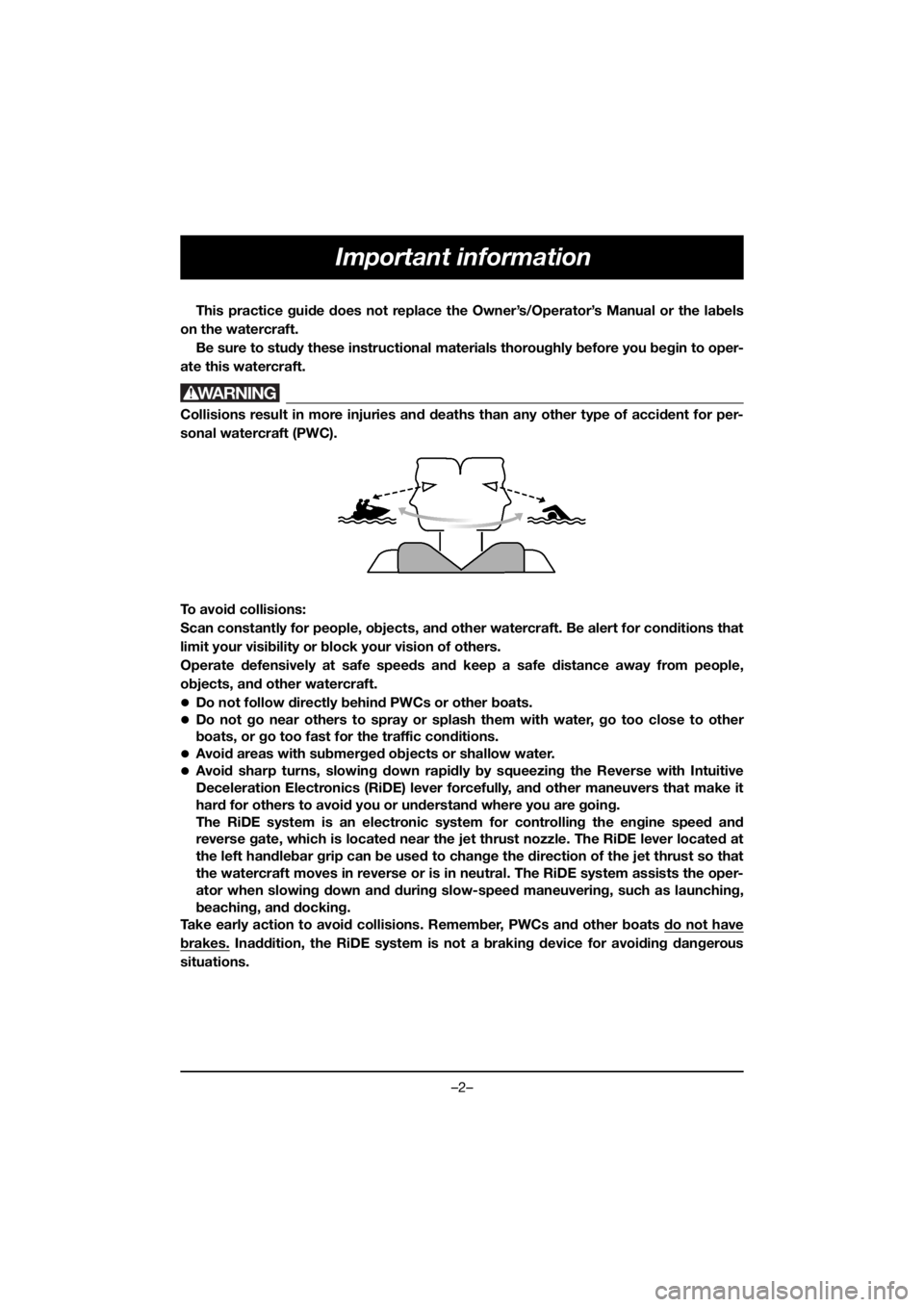lock YAMAHA FJR1300 2020 ΟΔΗΓΌΣ ΧΡΉΣΗΣ (in Greek)
[x] Cancel search | Manufacturer: YAMAHA, Model Year: 2020, Model line: FJR1300, Model: YAMAHA FJR1300 2020Pages: 198, PDF Size: 4.85 MB
Page 7 of 198

–2–
Important information
This practice guide does not replace the Owner’s/Operator’s Manual or the labels
on the watercraft.
Be sure to study these instructional materials thoroughly before you begin to oper-
ate this watercraft.
WWARNING
Collisions result in more injuries and deaths than any other type of accident for per-
sonal watercraft (PWC).
To avoid collisions:
Scan constantly for people, objects, and other watercraft. Be alert for conditions that
limit your visibility or block your vision of others.
Operate defensively at safe speeds and keep a safe distance away from people,
objects, and other watercraft.
Do not follow directly behind PWCs or other boats.
Do not go near others to spray or splash them with water, go too close to other
boats, or go too fast for the traffic conditions.
Avoid areas with submerged objects or shallow water.
Avoid sharp turns, slowing down rapidly by squeezing the Reverse with Intuitive
Deceleration Electronics (RiDE) lever forcefully, and other maneuvers that make it
hard for others to avoid you or understand where you are going.
The RiDE system is an electronic system for controlling the engine speed and
reverse gate, which is located near the jet thrust nozzle. The RiDE lever located at
the left handlebar grip can be used to change the direction of the jet thrust so that
the watercraft moves in reverse or is in neutral. The RiDE system assists the oper-
ator when slowing down and during slow-speed maneuvering, such as launching,
beaching, and docking.
Take early action to avoid collisions. Remember, PWCs and other boats do not have
brakes. Inaddition, the RiDE system is not a braking device for avoiding dangerous
situations.
F4L-T71-forPrint.book Page 2 Wednesday, July 3, 2019 10:38 AM
Page 18 of 198

–13–
Exercise 4: Trolling speed maneuvering
Objective:
This exercise familiarizes you with the watercraft’s handling characteristics at trolling
speed. It teaches techniques you will use when beaching, docking, or approaching
objects.
Skills:
Starting and turning at trolling speed.
Directions:
Drill 1: Moving straight and turning at trolling speed
1. Board the watercraft, and check for people, objects and other watercraft.
2. Start the engine and go straight ahead.
3. Begin to turn, making a large figure eight about 15–21 m (50–70 ft) long. Do not apply
throttle.
Drill 2: Making full-lock turns at trolling speed
1. Turn the handlebars as far as possible in either direction. Allow the watercraft to turn
360°.
2. Practice turning both clockwise and counterclockwise to get a feel for how the water-
craft responds to handlebar movement.
F4L-T71-forPrint.book Page 13 Wednesday, July 3, 2019 10:38 AM